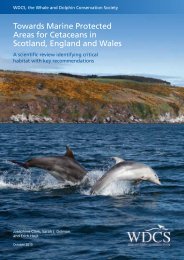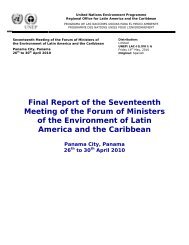Sea Turtle Recovery Action Plan for Barbados - WIDECAST
Sea Turtle Recovery Action Plan for Barbados - WIDECAST
Sea Turtle Recovery Action Plan for Barbados - WIDECAST
You also want an ePaper? Increase the reach of your titles
YUMPU automatically turns print PDFs into web optimized ePapers that Google loves.
The series of CEP Technical Reports contains selected in<strong>for</strong>mation resulting from the<br />
various activities per<strong>for</strong>med within the framework of the UNEP Caribbean Environment Programme<br />
(CEP). CEP was initiated in 1976 by UNEP with the assistance of ECLAC, at the<br />
request of the Governments of the region. A framework <strong>for</strong> regional projects and activities<br />
was first <strong>for</strong>mulated in Montego Bay in 1981, when the <strong>Action</strong> <strong>Plan</strong> <strong>for</strong> the Caribbean Environment<br />
Programme was adopted by the First Intergovernmental Meeting.<br />
The major legal instrument of CEP was adopted at the Second Intergovernmental<br />
Meeting, convened at Cartagena de Indias, in 1983: the Convention <strong>for</strong> the Protection and<br />
Development of the Marine Environment in the Wider Caribbean Region. The Cartagena<br />
Convention provides a framework <strong>for</strong> the development of specific protocols.<br />
The implementation of CEP is supported by the Caribbean Trust Fund, established by<br />
the participating States and Territories. Their active participation is ensured through regular<br />
Intergovernmental and Contracting Parties Meetings, a rotating Monitoring Committee<br />
<strong>for</strong>med by representatives from nine States and Territories and through the National Focal<br />
Points. The principal focal point in each State or Territory is the ministry or department responsible<br />
<strong>for</strong> external relations or <strong>for</strong>eign affairs. Additionally, the agency responsible <strong>for</strong><br />
the management of marine and coastal resources is the focal point <strong>for</strong> technical purposes.<br />
Currently, the <strong>Action</strong> <strong>Plan</strong> of CEP concentrates in six major areas <strong>for</strong> the management<br />
of marine and coastal resources: Overall Co-ordination, Specially Protected Areas and<br />
Wildlife (SPAW), Assessment and Control of Marine Pollution (CEPPOL), Integrated <strong>Plan</strong>ning<br />
and Institutional Development (IPID), In<strong>for</strong>mation Systems (CEPNET), and Education,<br />
Training and Awareness (ETA).<br />
*<br />
The Protocol Concerning Specially Protected Areas and Wildlife (SPAW) to the<br />
Cartagena Convention was adopted in two stages: the text of the Protocol was adopted on 18<br />
January 1990 and the initial Annexes listing relevant marine and coastal species, were<br />
adopted on 11 June 1991. The Protocol will enter into <strong>for</strong>ce following ratification by nine<br />
Contracting Parties.<br />
The Regional Programme <strong>for</strong> Specially Protected Areas and Wildlife in the Wider<br />
Caribbean Region (SPAW) was designed to implement the provisions and requirements of<br />
the SPAW Protocol. Its objectives are: (a) to develop specific management plans <strong>for</strong> economically<br />
and ecologically important species; (b) to significantly increase the number of<br />
adequately managed protected areas and species in the region; and © to develop a strong regional<br />
capability <strong>for</strong> the co-ordination of in<strong>for</strong>mation exchange, training and technical assistance<br />
in support of national, subregional and regional ef<strong>for</strong>ts on management of protected<br />
areas and wildlife.

















